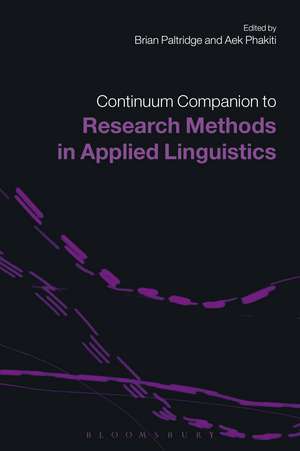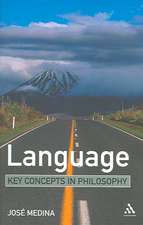Continuum Companion to Research Methods in Applied Linguistics
Editat de Brian Paltridge, Aek Phakitien Limba Engleză Paperback – 3 feb 2010
The Continuum Companion to Research Methods in Applied Linguistics is designed to be the essential one-volume resource for students. The book includes:
* qualitative and quantitative methods
* research techniques and approaches
* ethical considerations
* sample studies
* a glossary of key terms
* resources for students
* research techniques and approaches
* ethical considerations
* sample studies
* a glossary of key terms
* resources for students
As well as covering a range of methodological issues it looks at numerous areas in depth, including researching gender and language, language and identity, pragmatics, vocabulary, and grammar. Comprehensive and accessible, this will be the essential guide to research methods for undergraduate and postgraduate students in applied linguistics and language studies.
| Toate formatele și edițiile | Preț | Express |
|---|---|---|
| Paperback (1) | 309.31 lei 43-57 zile | |
| Bloomsbury Publishing – 3 feb 2010 | 309.31 lei 43-57 zile | |
| Hardback (1) | 1069.57 lei 43-57 zile | |
| Bloomsbury Publishing – 3 feb 2010 | 1069.57 lei 43-57 zile |
Preț: 309.31 lei
Preț vechi: 335.23 lei
-8% Nou
Puncte Express: 464
Preț estimativ în valută:
59.19€ • 61.57$ • 48.87£
59.19€ • 61.57$ • 48.87£
Carte tipărită la comandă
Livrare economică 14-28 aprilie
Preluare comenzi: 021 569.72.76
Specificații
ISBN-13: 9780826499257
ISBN-10: 0826499252
Pagini: 384
Ilustrații: black & white illustrations, black & white tables, figures
Dimensiuni: 156 x 234 x 23 mm
Greutate: 0.57 kg
Editura: Bloomsbury Publishing
Colecția Continuum
Locul publicării:London, United Kingdom
ISBN-10: 0826499252
Pagini: 384
Ilustrații: black & white illustrations, black & white tables, figures
Dimensiuni: 156 x 234 x 23 mm
Greutate: 0.57 kg
Editura: Bloomsbury Publishing
Colecția Continuum
Locul publicării:London, United Kingdom
Caracteristici
Each chapter includes: a general overview, research techniques and methodologies, a sample study which illustrates the methodology and resources for the student.
Cuprins
List of contributors
1. Introduction, Brian Paltridge and Aek Phakiti (University of Sydney, Australia)
Part I: Research methods and approaches
2. Experimental research, Susan Gass (Michigan State University, USA)
3. Survey research, Elvis Wagner (Temple University, USA)
4. Analysing quantitative data, Aek Phakiti (University of Sydney, Australia)
5. Ethnographies, Sue Starfield (University of New South Wales, Australia)
6. Case studies, Christine Pearson Casanave (Temple University, Tokyo)
7. Action research, Anne Burns (Macquarie University, Australia)
8. Analysing qualitative data, Adrian Holliday (Christ Church University, UK)
9. Research syntheses, Lourdes Ortega (University of Hawa'ii, USA)
10. Critical research in applied linguistics, Steven Talmy (University of British Columbia, Canada)
Part II: Areas of research
11. Researching speaking, Rebecca Hughes (University of Nottingham, UK)
12. Researching listening, Larry Vandergrift (University of Ottawa, Canada)
13. Researching reading, Marie Stevenson (University of Sydney, Australia)
14. Researching writing, Ken Hyland (University of London, UK)
15. Researching grammar, Neomy Storch (University of Melbourne, Australia)
16. Researching vocabulary, David Hirsh (University of Sydney, Australia)
17. Researching pragmatics, Carsten Roever (University of Melbourne, Australia)
18. Researching discourse, Brian Paltridge and Wei Wang (University of Sydney, Australia)
19. Researching language classrooms, Lesley Harbon and Huizhong Shen (University of Sydney, Australia)
20. Researching language testing, John Read (University of Auckland, New Zealand)
21. Researching motivation, Lindy Woodrow (University of Sydney, Australia)
22. Researching language and gender, Jane Sunderland (Lancaster University, UK)
23. Researching language and identity, David Block (University of London, UK)
Glossary of key research terms
Index
1. Introduction, Brian Paltridge and Aek Phakiti (University of Sydney, Australia)
Part I: Research methods and approaches
2. Experimental research, Susan Gass (Michigan State University, USA)
3. Survey research, Elvis Wagner (Temple University, USA)
4. Analysing quantitative data, Aek Phakiti (University of Sydney, Australia)
5. Ethnographies, Sue Starfield (University of New South Wales, Australia)
6. Case studies, Christine Pearson Casanave (Temple University, Tokyo)
7. Action research, Anne Burns (Macquarie University, Australia)
8. Analysing qualitative data, Adrian Holliday (Christ Church University, UK)
9. Research syntheses, Lourdes Ortega (University of Hawa'ii, USA)
10. Critical research in applied linguistics, Steven Talmy (University of British Columbia, Canada)
Part II: Areas of research
11. Researching speaking, Rebecca Hughes (University of Nottingham, UK)
12. Researching listening, Larry Vandergrift (University of Ottawa, Canada)
13. Researching reading, Marie Stevenson (University of Sydney, Australia)
14. Researching writing, Ken Hyland (University of London, UK)
15. Researching grammar, Neomy Storch (University of Melbourne, Australia)
16. Researching vocabulary, David Hirsh (University of Sydney, Australia)
17. Researching pragmatics, Carsten Roever (University of Melbourne, Australia)
18. Researching discourse, Brian Paltridge and Wei Wang (University of Sydney, Australia)
19. Researching language classrooms, Lesley Harbon and Huizhong Shen (University of Sydney, Australia)
20. Researching language testing, John Read (University of Auckland, New Zealand)
21. Researching motivation, Lindy Woodrow (University of Sydney, Australia)
22. Researching language and gender, Jane Sunderland (Lancaster University, UK)
23. Researching language and identity, David Block (University of London, UK)
Glossary of key research terms
Index
Recenzii
The collection is recommended not only to the students who are its intended readership, but also to supervisors of specific topics and to lecturers on research methods wanting up-to-date summaries.
... this is a really welcome book: engaging, readable, personable, accessible, useful, and interesting. I would certainly recommend it to beginner research students.
This important volume, the work of a diverse group of experienced researchers, introduces beginning researchers to the available resources on research approaches to language teaching and learning...it is an excellent companion to anyone interested in doing research in Applied Linguistics. The book is relevant to students as well as experienced researchers as, apart from succinctly describing principal concepts in research methodology, it also provides references useful for further investigation...The key issues and sociolinguistic areas relevant to research methods are clearly addressed in the Companion, making it an invaluable resource for language teaching and learning. The strength of the Companion is in the clear and cohesive structure of both parts of the volume, the clarity of style consistent throughout, and practical illustrations make the book a very valuable and motivating read.
... this is a really welcome book: engaging, readable, personable, accessible, useful, and interesting. I would certainly recommend it to beginner research students.
This important volume, the work of a diverse group of experienced researchers, introduces beginning researchers to the available resources on research approaches to language teaching and learning...it is an excellent companion to anyone interested in doing research in Applied Linguistics. The book is relevant to students as well as experienced researchers as, apart from succinctly describing principal concepts in research methodology, it also provides references useful for further investigation...The key issues and sociolinguistic areas relevant to research methods are clearly addressed in the Companion, making it an invaluable resource for language teaching and learning. The strength of the Companion is in the clear and cohesive structure of both parts of the volume, the clarity of style consistent throughout, and practical illustrations make the book a very valuable and motivating read.















